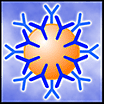 |
Antibody-dependent cellular cytotoxicity (ADCC), a lytic attack on antibody-targeted cells, is triggered on binding of lymphocyte receptors (Fc Rs) to the antibody constant region. ADCC is considered to be a major therapeutic function of antibodies, although there are others (e.g., antigen binding, induction of apoptosis, and complement-dependent cellular cytotoxicity (CDC)) (1). Rs) to the antibody constant region. ADCC is considered to be a major therapeutic function of antibodies, although there are others (e.g., antigen binding, induction of apoptosis, and complement-dependent cellular cytotoxicity (CDC)) (1).
One IgG molecule contains two asparagine N-linked oligosaccharide sites in its Fc region. The general structure of IgG N-linked oligosaccharides is complex-type, characterized by a mannosyl-chitobiose core with or without bisecting N-acetylglucosamine (GlcNAc)/L-fucose and other chain variants including the presence or absence of galactose and sialic acid (Fig.1). ADCC requires the presence of oligosaccharides in the Fc region and is sensitive to change in the oligosaccharide structure. Several groups have reported that ADCC enhancement can be achieved by manipulating human IgG1 subclass antibody oligosaccharides. Among all of the sugar components in the oligosaccharide, galactose, bisecting-GlcNAc, and fucose have been reported to affect ADCC. Although the influence of the refined Fc oligosaccharide structures on ADCC of IgG has long been a matter of debate, Shields et al. and our group have found that the most important carbohydrate structure in terms of the enhancement of ADCC is the fucose attached to the innermost GlcNAc of the biantennary complex-type oligosaccharides (2,3). The removal of fucose residues from the biantennary complex-type oligosaccharides attached to the Fc dramatically enhanced the ADCC of the antibodies (Fig.2) (3) due to improved Fc RIIIa binding without altering either antigen binding or CDC activity (4,5,6). Defucosylated antibodies achieve high effector activity at low doses, including high cellular cytotoxicity against tumor cells that express low levels of antigen, and triggering high effector function in NK cells with the low-affinity Fc RIIIa binding without altering either antigen binding or CDC activity (4,5,6). Defucosylated antibodies achieve high effector activity at low doses, including high cellular cytotoxicity against tumor cells that express low levels of antigen, and triggering high effector function in NK cells with the low-affinity Fc RIIIa allotype (Fc RIIIa allotype (Fc RIIIa-Phe158) for currently licensed therapeutic antibodies (6,7). The superior in vivo efficacy of defucosylated antibody has also been demonstrated using a human PBMC-engrafted mouse model (8). IgG bearing the Fc biantennary complex type of oligosaccharides lacking for fucosylation is a normal component of natural human serum IgG and therefore there is little concern regarding its intrinsic immunogenicity. Thus, the application of defucosylated antibodies is expected to be among the most powerful and elegant approaches to the development of the next generation of therapeutic antibodies. RIIIa-Phe158) for currently licensed therapeutic antibodies (6,7). The superior in vivo efficacy of defucosylated antibody has also been demonstrated using a human PBMC-engrafted mouse model (8). IgG bearing the Fc biantennary complex type of oligosaccharides lacking for fucosylation is a normal component of natural human serum IgG and therefore there is little concern regarding its intrinsic immunogenicity. Thus, the application of defucosylated antibodies is expected to be among the most powerful and elegant approaches to the development of the next generation of therapeutic antibodies.
| |
|
| References |
(1) |
Satoh M, Shitara K, Hanai N: The Current Stream and Prospect of Glycoscience Application-Therapeutic Antibodies. TIGG, 18, 129-136, 2006 |
|
(2) |
Shields RL, Lai J, Keck R, O’Connell LY, Hong K, MengYG, Weikert SHA, Presta LG: Lack of fucose on human IgG1 N-linked oligosaccharide improves binding to human Fcgamma RIII and antibody-dependent cellular toxicity. J.Biol. Chem. 277, 26733-26740, 2002 |
|
(3) |
Shinkawa T, Nakamura K, Yamane N, Shoji-Hosaka E, KandaY, Sakurada M, Uchida K, Anazawa H, Satoh M, Yamasaki M, Hanai N, Shitara K: The absence of fucose but not the presence of galactose or bisecting N-acetylglucosamine of human IgG1 complex-type oligosaccharides shows the critical role of enhancing antibody-dependent cellular cytotoxicity. J.Biol. Chem.278, 3466-3473 2003 |
|
(4) |
Okazaki A, Shoji-Hosaka E, Nakamura K, Wakitani M, Uchida K, Kakita S, Tsumoto K, Kumagai I, Shitara K: Fucose depletion from human IgG1 oligosaccharide enhances binding enthalpy and association rate between IgG1 and FcgammaRIIIa. J. Mol. Biol.336, 1239-1249, 2004 |
|
(5) |
Niwa R, Hatanaka S, Shoji-Hosaka E, Sakurada M, Kobayashi Y, Uehara A, Yokoi H, Nakamura K, Shitara K: Enhancement of the antibody-dependent cellular cytotoxicity of low-fucose IgG1 Is independent of FcgammaRIIIa functional polymorphism. Clin. Cancer Res.10, 6248-6255, 2004 |
|
(6) |
Yamane-Ohnuki N, Kinoshita S, Inoue-Urakubo M, Kusunoki M, Iida S, Nakano R, Wakitani M, Niwa R, Sakurada M, Uchida K, Shitara K, Satoh M: Establishment of FUT8 knockout Chinese hamster ovary cells: an ideal host cell line for producing completely defucosylated antibodies with enhanced antibody-dependent cellular cytotoxicity. Biotechnol. Bioeng.87, 614-622, 2004 |
|
(7) |
Niwa R, Sakurada M, Kobayashi Y, Uehara A, Matsuhima K, Ueda R, Nakamura K, Shitara K: Enhanced natural killer cell binding and activation by low-fucose IgG1 antibody results in potent antibody-dependent cellular cytotoxicity induction at lower antigen density. Clin. Cancer Res.11, 2327-2336, 2005 |
|
(8) |
Niwa, R, Shoji-Hosaka E, Sakurada M, Shinkawa T, Uchida K, Nakamura K, Matsushima K, Ueda R, Hanai N, Shitara K: Defucosylated chimeric anti-CC chemokine receptor 4 IgG1 with enhanced antibody-dependent cellular cytotoxicity shows potent therapeutic activity to T-cell leukemia and lymphoma.Cancer Res.64, 2127-2133, 2004 |
|
|
|
|
|



